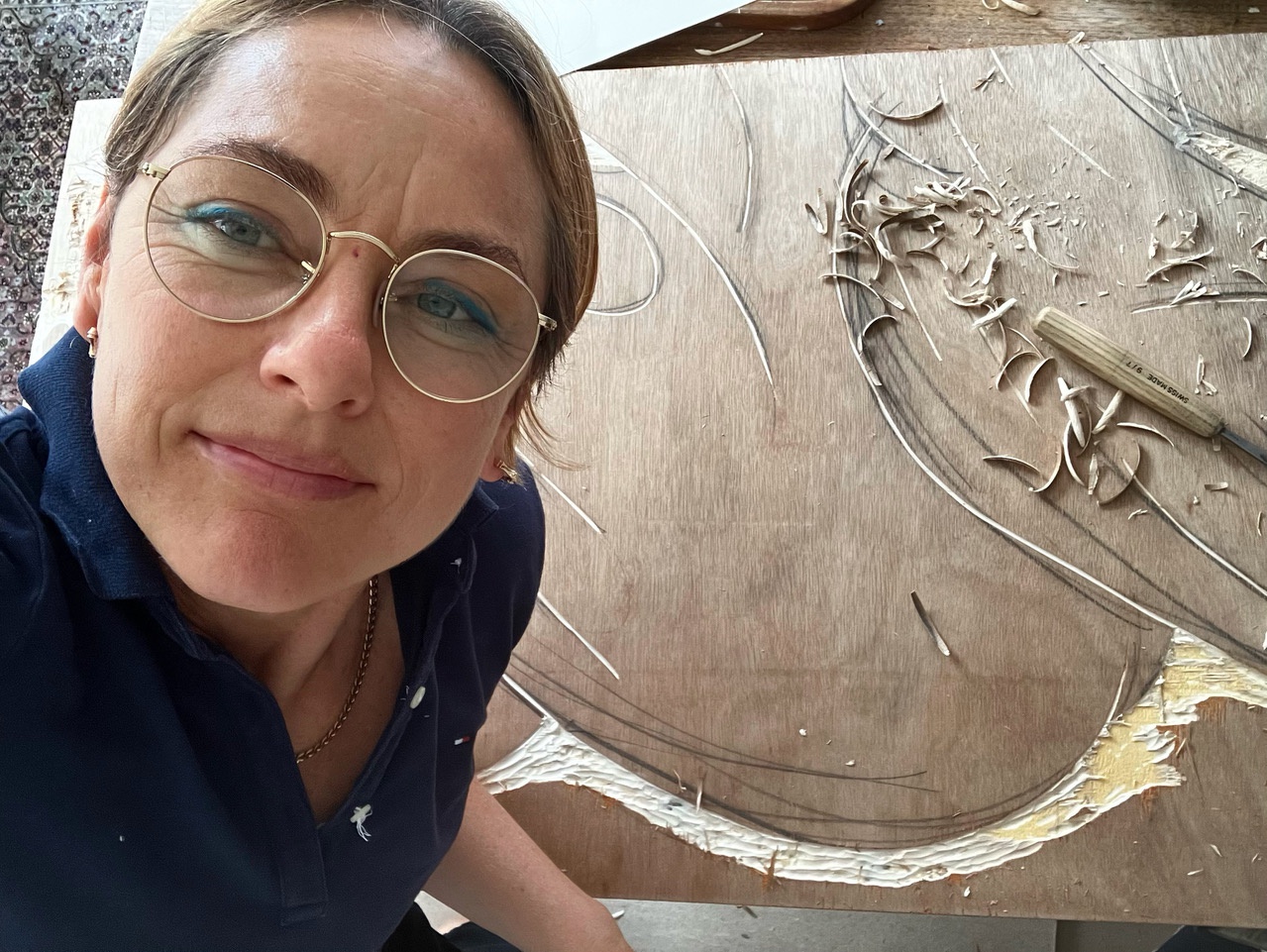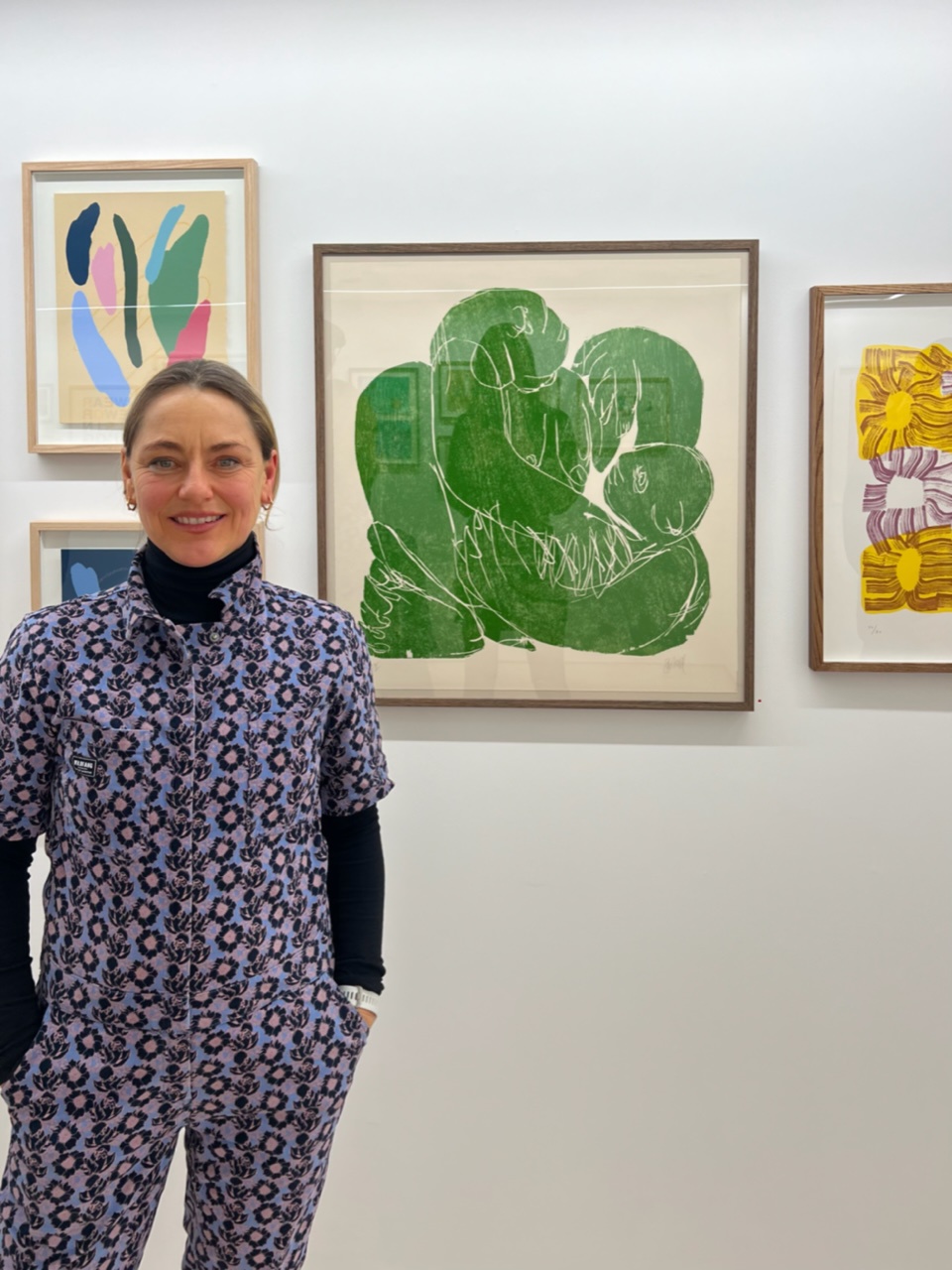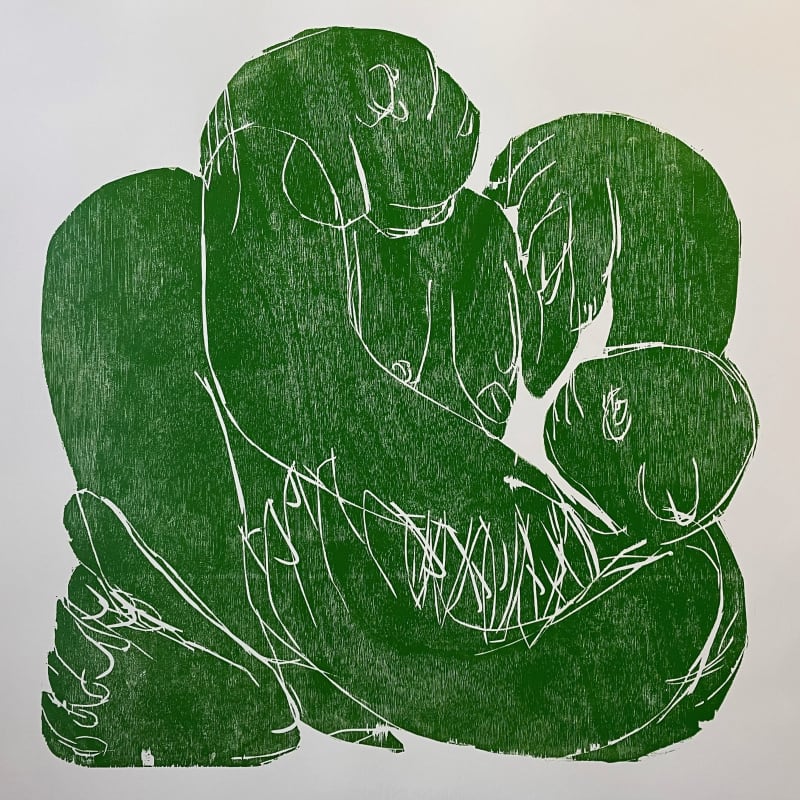Barbara Kuebel’s art practice is inspired by a never-ending search for being. The contemporary Austrian artist is now based in the UK, working primarily in woodcut printing. Taking an abstract expressionist approach to figurative motifs, she creates emotive and fluid portraits that echo her conceptual, philosophical inspiration. She draws from bodily experiences and spontaneous emotion, alongside the sensation of movement to construct her imaginative characters, depicted in evocative, monochrome colour palettes. Kuebel’s recent print works, And it’s always the people / Und es sind immer die Menschen I & II (2023) are currently on view in the works on paper group exhibition ORIGINS. (Continues until 27th January 2024).

We took a moment with the artist to discuss her practice and inspirations.
How long have you been printmaking for and how did you learn this skill?
I have been printmaking since I started art school at the Academy of Fine Art Vienna. Students from all backgrounds had the opportunity to experiment with new mediums. I was originally allocated to painting, however I immediately fell in love with printmaking and sculpting. It was a great way of expressing myself.
What inspired you to choose wood block printing as your main medium of printmaking?
I originally decided to work with wood as it allows me to work in a large-scale format, whilst also allowing me to finance my own materials. Wood combined all these elements. It was cheap, yet still offered me the chance to engage with the material in a very direct way. Another reason is that wood does not need a lot of preparation – it was a raw material that was there when I needed it. Woodblock printing does not entail much preparation or chemical usage. One can do it outside without the use of many tools.
How long does each limited edition take to produce?
In the past, I have submitted blocks for publications, and the edition was professionally printed through a printer on a printing press. Since I started working in large, very limited editions of mainly just five pieces: the time to cut the block is about one week. The printing process for this size is three hours by hand, and the drying about two weeks. Altogether, it takes about one month to finish one piece. Smaller pieces take much less time - maybe three days for an edition of five.
What is your inspiration behind the figures you depict in your work?
Probably the constant search for being. I was always drawn to figurative work out of a more physical aspect. I have always been a very sporty person, and I consider sports as an act of freeing yourself and thinking about yourself as a creature. Contemplating what is outside the body, what is inside, how far can one trust one’s own abilities and perspectives, all from a very natural point of view. The figures I depict in my work are hybrids, experiencing external elements such as nature, environment, movement... They are superior creatures that cannot be blamed, asked, or expected to give answer. This gives me the chance to redefine the form independently from a given environment. They are real figures shaped by an imaginary setting - not inevitably human.
How do you choose the titles for your work?
The titles are like names and come after the piece is finished. Most of my titles describe the process resulting in the work.
What does your work aim to say?
There are different frameworks which I consider as important. One is material. I think that the understanding of material or what materials mean is more culturally shaped than meaning or message of an artwork. In the regions I consider myself as artistically related to, wood is a material which has been used in many ways and many places. The alpine regions of Austria and Switzerland used wood as a crucial resource for building a cultural environment. Here, people understand its uses, functions, and how to handle it. Consequently, wood is historically treated as a medium which people would instantly choose and value. For instance, I think of house constructions in the mountains, and delicate sculpturing works for spiritual purposes. To know materials means to see beauty even in simple things.
From a formal side it is limitation. I create monochromatic prints to let the material speak. One colour is enough to define the surface through the printing process, which I do by hand. As a matter of fact, I do not believe that overproduced pieces give deeper sensation and more profound meaning to a work. It is not my intention to produce pieces with numerous blocks, or to risk getting lost in delicate detail. I want wood to be present in my works, though technically it is just the paper which is there in the end.
Can you tell us about your studio process and how you take an idea and then turn this into a print?
I have a small studio. Funnily enough, I always did art in places located in the countryside with untouched nature close by. I previously lived in Alabama, where the “jungle” with snakes and coyotes was a mere 5 meters behind the family house. Now, living in Cleethorpes, I am about 200 meters to the beach. My mind feels to be freer here, but the blocks I use for the large prints have always been the same size; one square with endless options to engage graphically. In the end I do not feel guilty not to “act out of the box.” My process is like a diary, with a new page to fill each day; it feels like a constant stream of expressing myself.
What’s the best bit of advice you have ever received about being an artist and printmaker?
As a student, I wasn’t very skilled. My professor - a wise man – said: “Do not change yourself”. I felt relieved. This taught me that all forms of expression are appropriate; this is also how I feel looking at art. I feel good that the line and the surface is what counts for me.

Can you tell us about the history of woodblock printing? How does this influence your process?
Although I appreciate them, some historical techniques are difficult to keep up. My personal approach draws on the principle of book-printing, which simply uses one colour per edition. I hope to see printmaking move away from the modern-day technique (which priorities being extremely uniform), allowing for organic inconsistencies to be present within the work.
What is your preferred ink to use? How do you choose the colours for each work?
I tend to use oil-based colours for my printing. Mostly Charbonnel LuxeC for black and Charbonnel colours for the rest of my work. I usually have the colour in my mind before starting the printing; so it is an important part of each piece.
What is the most challenging part of printmaking?
The most challenging part of printmaking for me is keeping the paper clean. Another challenge is transferring the large pieces of paper onto the block. I often need help for this part of the process as I cannot do this alone.
You can purchase Barbara's editions here or email info@rhodeseditions.com for more information.
